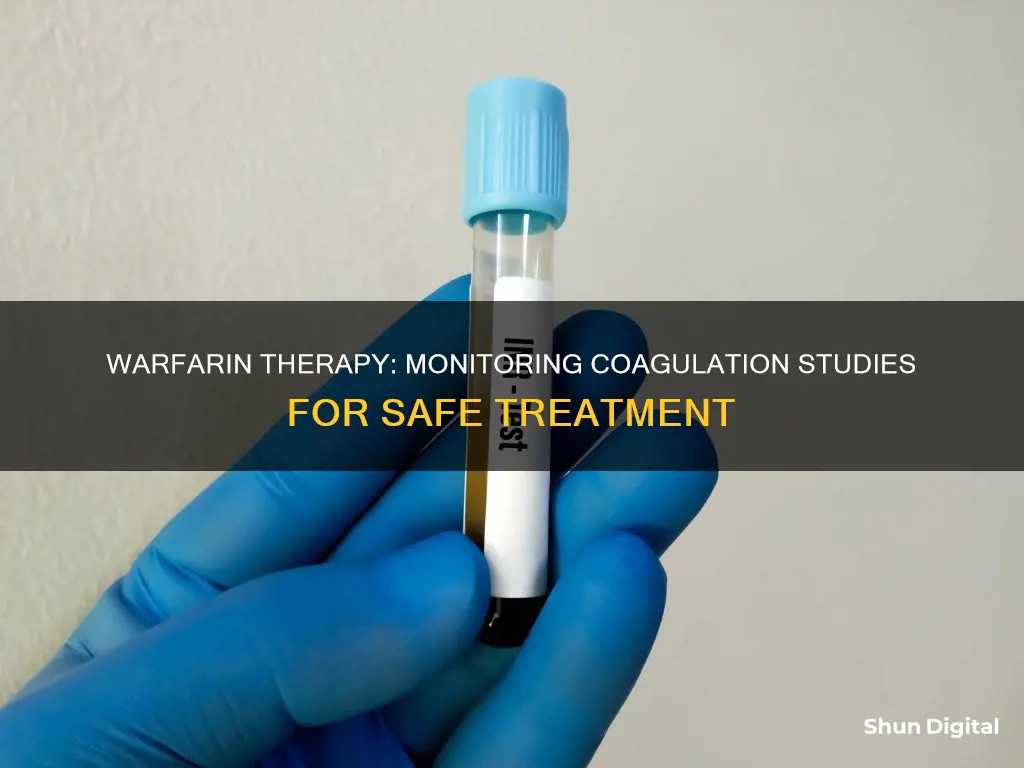
Warfarin is an anticoagulant medication used to prevent and treat blood clots. It is important to monitor a patient's blood coagulation levels when they are taking warfarin to ensure the medication is working effectively and to minimise adverse events such as bleeding. This is done through a prothrombin time (PT) test, which measures how long it takes for a clot to form in a blood sample. The results of this test can vary depending on the lab or test method, so it is often reported as an international normalized ratio (INR). INR levels that are too low may indicate a risk of dangerous blood clots, while levels that are too high may mean the patient is at risk of excessive bleeding.
| Characteristics | Values |
|---|---|
| What it measures | How many seconds it takes for a clot to form in a blood sample |
| Why it's done | To see how well warfarin is working to prevent blood clots |
| How often it's done | When first starting warfarin, it may be done every few days or weekly. When results are stable, it's often done every 2–4 weeks, sometimes longer. |
| What affects the results | Illness (e.g. diarrhoea or fever); eating more or less vitamin K-rich foods; changes in medicines, weight, or activity level |
What You'll Learn

Prothrombin Time (PT) test
The prothrombin time (PT) test is a common procedure for patients taking warfarin, an anticoagulant or blood-thinning medication. PT tests measure the time it takes for a blood sample to clot, with results given in seconds. This test is important for patients on warfarin as it helps determine if their blood is clotting normally and if the medication is working effectively to prevent blood clots.
The test is typically performed on a blood sample taken from a vein in the arm using a small needle. It can also be done using a fingertip blood sample, which can be collected in a provider's office or at home with an at-home testing kit. The process usually takes less than five minutes and may cause minor discomfort, such as a slight sting or bruising, which quickly subsides.
Test Results and Interpretation
PT test results are often presented as INR (international normalized ratio) levels to standardise the results across different laboratories and test methods. INR levels that are too low indicate an increased risk of dangerous blood clots due to the blood clotting too easily. On the other hand, high INR levels suggest a higher risk of excessive bleeding as the blood is taking longer than normal to form a clot.
For patients taking warfarin, healthcare providers typically aim to maintain INR levels between 2.0 and 3.0. If the INR deviates from this target range, the warfarin dosage may need to be adjusted.
Precautions and Considerations
Certain medications, herbal remedies, and dietary factors can influence PT/INR test results. Therefore, it is important to inform your healthcare provider about any substances you are consuming before the test. Additionally, if you are taking warfarin, your provider may instruct you to delay your daily dose until after the test.
Efficiently Removing a LINQ Monitor: A Step-by-Step Guide
You may want to see also

International Normalized Ratio (INR)
The International Normalized Ratio (INR) is a test that measures how long it takes for a person's blood to clot. It is used to monitor patients taking warfarin, an anticoagulant or blood-thinning medication, to ensure they are taking the correct dose. Warfarin is used to treat and prevent blood clots and is prescribed to prevent strokes and treat conditions such as deep vein thrombosis and pulmonary embolism.
The INR is derived from the prothrombin time (PT) test, which measures how many seconds it takes for a clot to form in a blood sample. The PT results can vary depending on the lab or test method, so the INR standardises the results, making it easier for healthcare providers to compare and understand results from different sources.
INR testing is important for patients taking warfarin because it helps determine if their blood is clotting too slowly or too quickly. If the INR is too high, the patient is at risk of dangerous bleeding. If it is too low, they are at risk of dangerous blood clots. The INR value is typically between 2.0 and 3.0 for people on anticoagulant therapy, while a healthy person not on anticoagulants will usually have an INR of 1.0.
INR testing is typically done on a blood sample from a vein in the arm, but it can also be done via a fingertip test, especially for patients taking warfarin long-term. The frequency of INR testing depends on the patient's condition and provider discretion, but it is often done every 3-4 weeks for patients on warfarin.
The INR value is used to adjust the warfarin dosage to reach the target INR range, balancing the risk of blood clots and bleeding. Other factors that can affect INR values include diet, drug interactions, and patient characteristics. Close monitoring of INR levels is crucial for patients taking warfarin to ensure therapeutic effectiveness and minimise adverse events.
Spirits Among Us: How to Spot Monitoring Spirits
You may want to see also

Partial Thromboplastin Time (PTT) test
The partial thromboplastin time (PTT) test is a screening test that uses a blood sample to measure how long it takes for a clot to form. It helps evaluate a person's ability to form blood clots properly. Normally, when a person gets a cut or injury, several types of proteins in the blood, called coagulation or clotting factors, work together to make a clot and stop the bleeding.
The PTT test specifically checks a specific group of clotting factors and shows how much of these factors are present and how well they are working. It is often done with another test called the prothrombin time (PT) test, which measures other clotting factors.
The PTT test is used to:
- Find the cause of excessive bruising or bleeding.
- Find the cause of clotting problems, which can be due to certain autoimmune diseases such as lupus or antiphospholipid syndrome (APS).
- Monitor people taking heparin, a medicine used to prevent and treat blood clots.
- Check the risk for possible bleeding problems before surgery or medical procedures.
The test is typically performed when a person:
- Has unexplained bleeding or bruising.
- Has a blood clot in a vein or artery.
- Has liver disease.
- Has had several miscarriages.
- Has been diagnosed with a bleeding or clotting disorder.
- Is taking heparin.
The PTT test is not used to monitor warfarin therapy, but at high doses, warfarin may prolong the PTT. Instead, the prothrombin time/international normalized ratio (PT/INR) is used to monitor warfarin therapy.
Setting Up ASUS Aura Sync on Your Monitor
You may want to see also

Vitamin K intake
Warfarin is an anticoagulant used to prevent and treat venous thrombosis and thromboembolic events, as well as conditions such as myocardial infarction and atrial fibrillation. It works by inhibiting the synthesis of vitamin K-dependent clotting factors, thereby reducing the body's ability to clot blood.
Vitamin K is an essential cofactor in the synthesis of clotting factors. When a person takes warfarin, it is important to monitor their vitamin K intake, as this can affect how well the medication works.
If a person taking warfarin suddenly increases their vitamin K intake, it can decrease the effect of warfarin. This is because vitamin K is necessary for the formation of blood clots. On the other hand, if a person taking warfarin does not have enough vitamin K in their diet, they may be at risk for dangerous bleeding.
Therefore, it is important for patients taking warfarin to maintain a consistent vitamin K intake. This can be achieved by paying attention to food labels and being mindful of portion sizes. Leafy greens, such as kale, spinach, and Brussels sprouts, are rich in vitamin K, as are some vegetable oils like soybean and canola oil.
It is also important to note that certain supplements, such as herbal and omega-3 supplements, may contain vitamin K and could interfere with warfarin. Patients taking warfarin should discuss their diet and any supplements they are taking with their doctor to ensure they are getting the right amount of vitamin K and the correct dosage of warfarin.
In addition to monitoring vitamin K intake, patients taking warfarin should also have their blood values checked regularly, including the prothrombin time (PT) and international normalized ratio (INR) tests, to ensure the medication is working effectively and to minimise the risk of adverse events such as bleeding.
Speaker Placement: Feet From Corner for Studio Monitors
You may want to see also

Bleeding risk
Warfarin is an anticoagulant used to prevent and treat venous thrombosis and thromboembolic events. It is also used to treat conditions such as myocardial infarction and atrial fibrillation. As an anticoagulant, warfarin inhibits the synthesis of vitamin K-dependent clotting factors, reducing the ability of the blood to clot. This reduction in clotting ability can lead to an increased risk of bleeding. Therefore, it is essential to closely monitor patients on warfarin therapy to ensure therapeutic effectiveness and minimize adverse events, such as bleeding.
The risk of bleeding while on warfarin therapy is influenced by various factors, including patient-related factors and laboratory parameters.
Patient-Related Risk Factors
Age, for instance, is a factor that influences bleeding risk, with older patients being at a higher risk of bleeding complications. This is particularly true for older adults, who are at an increased risk of bleeding due to falls, concomitant drug interactions, cognitive status, and unsafe living conditions.
The duration of warfarin use also plays a role in bleeding risk. The longer a patient is on warfarin, the higher the risk of bleeding, especially if the patient is over 80 years old and has an INR (International Normalized Ratio) level over 4.
Concomitant use of certain medications, such as acetylsalicylic acid (aspirin), can also increase the risk of bleeding. The risk of clinically important minor and major bleeding increases when acetylsalicylic acid and warfarin are used together.
Additionally, patient genetics can influence bleeding risk. Genetic variations in the CYP2C9 gene, for example, can affect warfarin clearance, and certain polymorphisms in the VKORC1 and CYP2C9 genes have been associated with a higher bleeding risk.
Laboratory Parameters
Laboratory parameters, such as INR levels and creatinine levels, are also important indicators of bleeding risk.
High INR levels are a significant risk factor for bleeding. INR levels that are too high indicate that the blood is taking longer than normal to form a clot, increasing the risk of dangerous bleeding.
Creatinine levels can also provide insights into bleeding risk. Patients with moderate to severe renal failure on warfarin tend to have higher INR levels and an increased risk of bleeding compared to those with normal kidney function.
To aid clinicians in assessing bleeding risk, several bleeding risk assessment tools have been developed. These tools take into account various clinical risk factors and patient characteristics to help quantify a patient's hemorrhage risk. Examples of such tools include the Outpatient Bleeding Risk Index (OBRI), the modified OBRI (mOBRI), the HEMORR2HAGES, the RIETE risk scheme, and the HAS-BLED score. However, it is important to note that these tools have only modest predictive ability, and none of them are highly predictive of intracranial hemorrhage, a severe outcome associated with warfarin use.
Finding the Input Selection Button on Your ASUS Monitor
You may want to see also
Frequently asked questions
Warfarin is an anticoagulant drug used to prevent and treat harmful blood clots. It is taken orally and works by slowing down the clotting process, thus keeping unwanted clots from forming inside blood vessels or the heart.
The Prothrombin Time (PT) test, also known as Protime, is used to monitor patients on warfarin. The test measures how long it takes for a clot to form in a blood sample.
When first starting warfarin, patients may need the PT test as frequently as every few days or weekly. Once the warfarin dose is stable, the test is typically done every 2 to 4 weeks, or even longer.
The PT test results are reported as the International Normalized Ratio (INR). INR levels that are too low indicate a higher risk of dangerous blood clots, while levels that are too high mean an increased risk of bleeding.







